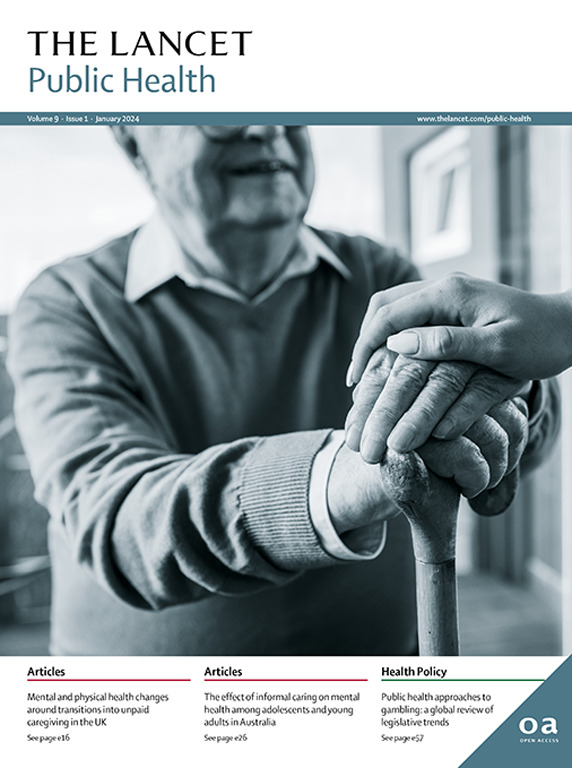Health effects of the Brazilian Conditional Cash Transfer programme over 20 years and projections to 2030: a retrospective analysis and modelling study
IF 25.4
1区 医学
Q1 PUBLIC, ENVIRONMENTAL & OCCUPATIONAL HEALTH
引用次数: 0
Abstract
Background
In 2024, Brazil celebrated the 20th anniversary of the Bolsa Família Program (BFP), one of the world's oldest and largest conditional cash transfer (CCT) programmes, covering more than 50 million Brazilians. This study aimed to evaluate the effect of the BFP on overall mortality and hospitalisation rates over the past two decades, and to forecast the potential effects of expanding this programme until 2030.Methods
This study combined retrospective impact evaluations in Brazil from 2000–19 with microsimulation models up to 2030. First, the effect of the BFP on overall mortality and hospitalisation rates was estimated across different age groups, adjusting for all relevant demographic, socioeconomic, and health-care factors. Fixed-effect multivariable Poisson models were then applied to 3671 municipalities with adequate quality vital statistics data. The three exposure variables of BFP were target coverage, benefits adequacy (average transfer per family), and the interaction of coverage and adequacy. Several sensitivity and triangulation analyses were conducted, including difference-in-difference models with propensity-score matching. Previous longitudinal datasets were then integrated with validated dynamic microsimulation models to project trends up to 2030.Findings
High coverage of BFP was associated with a significant reduction in overall age-standardised mortality rates (rate ratio [RR] 0·824 [95% CI 0·807–0·842]). High adequacy of BFP was associated with a reduction in overall age-standardised mortality (0·849 [0·833–0·866]). Our models estimated that the BFP prevented 8 225 390 (95% CI 8 192 730–8 257 014) hospitalisations and 713 083 (702 949–723 310) deaths in 2000–19. Stronger effects were found in BFP high coverage and high adequacy scenario, resulting in large reductions in under-5 mortality (RR 0·67 [95% CI 0·65–0·69]) and hospitalisation of individuals older than 70 years (0·52 [0·50–0·53]). Expanding BFP coverage could avert an additional 8 046 079 (95% CI 8 023 306–8 068 416) hospitalisations and 683 721 (676 494–690 843) deaths by 2030, compared with scenarios of reduced coverage.Interpretation
CCT programmes have strongly contributed to the reduction of morbidity and mortality in Brazil, having prevented millions of hospitalisations and deaths in the past two decades. During the current period of polycrisis, the expansion of CCTs in terms of coverage and benefits could prevent a large number of hospitalisations and deaths worldwide, and should be considered a crucial strategy for achieving the UN health-related Sustainable Development Goal 3.Funding
UK Foreign, Commonwealth and Development Office, UK Medical Research Council, and the Wellcome Trust (grant number MC_PC_MR/T023678/1).Translation
For the Portuguese translation of the summary see Supplementary Materials section.巴西有条件现金转移支付方案20年来对健康的影响及到2030年的预测:回顾性分析和建模研究
2024年,巴西庆祝Bolsa Família计划(BFP) 20周年,该计划是世界上历史最悠久、规模最大的有条件现金转移支付(CCT)计划之一,覆盖了5000多万巴西人。这项研究旨在评估过去二十年来BFP对总体死亡率和住院率的影响,并预测将该方案扩大到2030年的潜在影响。方法本研究将2000-19年巴西的回顾性影响评估与直至2030年的微观模拟模型相结合。首先,在对所有相关的人口、社会经济和保健因素进行调整后,估计了BFP对不同年龄组总死亡率和住院率的影响。然后将固定效应多变量泊松模型应用于具有足够质量生命统计数据的3671个城市。BFP的三个暴露变量为目标覆盖率、福利充分性(每个家庭平均转移)和覆盖率与充分性的相互作用。进行了一些敏感性和三角分析,包括倾向-得分匹配的差中差模型。然后将之前的纵向数据集与经过验证的动态微模拟模型相结合,预测到2030年的趋势。结果:高BFP覆盖率与总体年龄标准化死亡率显著降低相关(死亡率比[RR] 0.824 [95% CI] 0.87 - 0.842])。BFP的高充分性与总体年龄标准化死亡率的降低相关(0.849[0.833 - 0.866])。我们的模型估计,2000-19年间,BFP预防了8 225 390例(95%可信区间8 192 730-8 257 014)住院和713 083例(702 949-723 310)死亡。在BFP高覆盖率和高充分性情景中发现了更强的效果,导致5岁以下儿童死亡率(RR = 0.67 [95% CI = 0.65 - 0.69])和70岁以上个体住院率(0.52[0.50 - 0.53])大幅降低。与降低覆盖率的情景相比,到2030年,扩大基本生育计划覆盖率可避免额外的8 046 079例(95%可信区间8 023 306-8 068 416)住院病例和683 721例(676 494-690 843)死亡病例。有条件现金转移支付方案为降低巴西的发病率和死亡率做出了巨大贡献,在过去二十年中防止了数百万人住院和死亡。在当前的多重危机时期,扩大有条件现金援助的覆盖范围和福利可以在全球范围内防止大量住院和死亡,并应被视为实现联合国与卫生有关的可持续发展目标3的一项关键战略。资助:英国外交、联邦和发展部、英国医学研究理事会和威康信托基金(资助号MC_PC_MR/T023678/1)。有关摘要的葡萄牙语翻译,请参阅补充资料部分。
本文章由计算机程序翻译,如有差异,请以英文原文为准。
求助全文
约1分钟内获得全文
求助全文
来源期刊

Lancet Public Health
Medicine-Public Health, Environmental and Occupational Health
CiteScore
55.60
自引率
0.80%
发文量
305
审稿时长
8 weeks
期刊介绍:
The Lancet Public Health is committed to tackling the most pressing issues across all aspects of public health. We have a strong commitment to using science to improve health equity and social justice. In line with the values and vision of The Lancet, we take a broad and inclusive approach to public health and are interested in interdisciplinary research.
We publish a range of content types that can advance public health policies and outcomes. These include Articles, Review, Comment, and Correspondence. Learn more about the types of papers we publish.
 求助内容:
求助内容: 应助结果提醒方式:
应助结果提醒方式:


